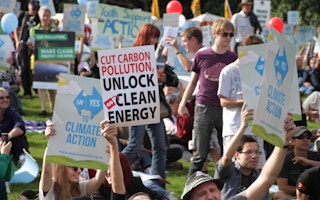Under the Paris climate agreement, Australia has stated that it will reduce greenhouse gas emissions by 26-28 per cent by 2030 compared to 2005 levels.
To limit temperature increases to less than 2°C, concentrations of greenhouse gases in the atmosphere need to be limited to 450 parts per million or lower . This would require reductions in global emissions of between 40 per cent and 70 per cent by 2050 and complete decarbonisation of the world economy by 2100.
The Climate Institute has found that under the most “generous” emission reduction methods, Australia’s total carbon budget between now and 2050 would need to be 10 billion tonnes of greenhouse gases or lower.
This budget would be depleted by around 2033 if Australia continued to emit greenhouse gases at current levels.
If the budget was exhausted more gradually at a fixed reduction rate, Australia would need to reduce its emissions by 4 per cent each year to 2050 – approximately 45 per cent lower than today in 2030.
Current policy settings likely to require enhancements
Achieving these emission reductions will be challenging under current policy settings. Australia needs to consider how it will implement long-term emission reduction policies that allow for existing capital stock, such as fossil-fuel-fired power stations in the electricity sector, to transition to low/zero emissions.
Australia’s policy initiatives should also focus on the strategic importance of our resources – primarily coal, gas and uranium. Australia has 33 per cent, 10 per cent and 2 per cent respectively of the world’s uranium, coal and gas resources and around 25 per cent of Australia’s goods export revenues are sourced from the sale of mineral fuels. Given the importance of these exports for the economy, greater consideration of appropriate and cost-effective policy mechanisms for these resource industries would be sensible.
Much of the public policy discussion is focused on whether a carbon price (a carbon tax or emissions trading scheme) should be introduced. Alternatives may be worth considering, particularly in capital intensive industries such as electricity.
In the US, new performance standards establish separate greenhouse gas limits for coal and gas generators. Coal plants will be required to meet a 12-month rolling average of 0.5 tonnes per megawatt-hour. Gas-fired generation facilities will be required to meet a limit of between 0.45-0.5 tonnes per megawatt-hour depending on their technical characteristics.
In Canada regulations force the retirement of power stations that are greater than 50 years old, or must be retrofitted with carbon capture and storage (CCS) technology to achieve an emissions profile of around 0.4 tonnes per megawatt-hour - equivalent to an efficient gas turbine.
The role of natural gas
Both Australia and the US are experiencing “gas revolutions”, but the outcomes with regards to gas prices could not be more different.
In Australia, gas prices and availability are being impacted by unprecedented increases in east-coast demand associated with the development of an east-coast LNG export industry.
“
Australia needs to consider how it will implement long-term emission reduction policies that allow for existing capital stock, such as fossil-fuel-fired power stations in the electricity sector, to transition to low/zero emissions.
Even without rising gas prices, to replace coal-fired power plants with gas turbines would take a carbon price of around A$110 per tonne.
This carbon price is more than four times higher than the previous Australian fixed carbon price of A$23 per tonne and would result in electricity price uplifts of roughly A$90 per megawatt-hour – an increase of 30 per cent on a residential bill . The A$23 carbon price caused household electricity bills to rise by around 10 per cent during the two years of its operation.
Barriers to exit and an ageing power station fleet are another key consideration for policy makers. Around 75 per cent of the existing thermal (coal and gas) generation plants have passed their original engineering life. More importantly, around 20 per cent are more than 40 years old.
While carbon pricing is likely to be difficult to implement due to political opposition and the effects of potentially higher gas prices, regulatory and legislative instruments are in place which have the effect of reducing emissions.
The most prominent of these is the Large-Scale Renewable Energy Target (LRET). Globally, such a policy is well founded – with 144 countries having support mechanisms for renewables of some type.
Electricity sector decarbonisation could be achieved with a renewable energy target if it was coupled with a policy to close old coal-fired power stations. This would be an adaption of performance standards for new electricity generators (such as those proposed in the US) and a closure policy (as adopted in Canada).
The role of carbon, capture and storage
It may also be in Australia’s interests to expand the Renewable Energy Target to include projects using coal and gas with zero or negligible emissions.
As a major exporter of coal and gas, Australia’s export revenues could be significantly curtailed without carbon capture and storage (CCS) technologies. Importantly, CCS should not be given a free-ride but would be required to compete with renewable sources.
Australia could advocate for other nations to adopt such a policy through international negotiations. This may create a deeper, liquid market for CCS-style technologies which would provide potential opportunities for Australian energy exporters.
If the policy objective is to structurally decarbonise the Australian economy, international permit trading may not result in greenhouse gas reduction actually taking place within Australia.
It may also do nothing to address the risks to Australian energy exports in a world where significant efforts are being made to substitute coal and gas.
In contrast, expanding the quantity and eligibility of zero-emissions abatement under the renewable energy target, combined with a Canadian-style generator closure policy, could both decarbonise the Australian electricity sector and provide opportunities for Australian energy exporters to compete in a zero emissions future.
This article is based upon a forthcoming article in Economic Papers titled, ‘Australian climate change policy: where to from here?’
![]()
Tim Nelson is PhD candidate, University of New England; Judith McNeill is Senior Research Fellow, Institute for Rural Futures, BCSS, UNE, University of New England; Mahinda Siriwardana is professor of economics, School of Business Economics and Public Policy, University of New England, and Sam Meng is Researcher in economics, University of New England. This article was originally published on The Conversation.









